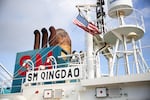Weekly international container shipping has returned to Portland.
South Korea-based container service SM Line made its first vessel call Tuesday morning, restoring weekly international container shipping to the Port of Portland’s Terminal 6 along the Columbia River. Oregon’s only international container terminal welcomed its inaugural carrier vessel after nearly four years since regular shipments ceased in the wake of tense labor disputes.

The SM Qingdao imported nearly 200 containers at Terminal 6 in Portland, Ore., on Tuesday, Jan. 14, 2020.
Donald Orr / OPB
Curtis Robinhold, executive director of the Port of Portland, said the port aims to rebuild the credibility Portland had in the market.
“We’ve really been focused on returning both Terminal 6 to profitability, [b]ut also to rebuild the relationship with shippers and with labor,” he said. “We really focused on those two areas to really get back both the credibility that we used to have in the market, but also to try and work out the commercial case to bring container service back.”
SM Line’s inaugural carrier vessel, the Qingdao, made a maiden voyage to Portland bringing nearly 200 containers for import. More than 70 export containers are heading to Korea, along with 330 empty containers for local shippers to utilize for exports on future vessel calls. The vessel made stops in Shanghai, China; Busan, South Korea; Vancouver, British Columbia; and Seattle before arriving at Terminal 6.

Port of Portland executive director Curtis Robinhold presents captain Kim Ex Soo with a celebratory plaque aboard the first SM Line vessel in Portland, Ore., on Tuesday, Jan. 14, 2020.
Donald Orr / OPB
“Their weekly container service provides an important option for regional shippers and will better connect Oregon businesses to global markets,” said Robinhold in a statement.
The port said that while items vary, the most common goods to leave Oregon include hay, lumber, animal feed, and agricultural commodities. Auto parts, furniture, bedding and lighting, and footwear and apparel are frequent Asian imports that arrive in Portland.
Unlike bigger ports along the West Coast like the one in Seattle, the Port of Portland sits inland on the Columbia River. The river depth is a constraint for most larger vessels and limits the size and number of vessels the port can receive.
“We saw [SM Line] as a great fit for the Columbia River; they’re a smaller, niche player in the Trans-Pacific trade, and they had the right size of ships that could call the river,” said Ken O’Hollaren, Marine Marketing Director for the Port of Portland.
In the last several years, Terminal 6 faced trouble in the shipping world after losing its previous terminal operator, ICTSI Oregon in 2017.
Back in November, a jury awarded ICTSI more than $93 million in damages from the International Longshore and Warehouse Union and its Portland chapter, finding the unions had engaged in unlawful labor practices that hurt the company. A federal judge delayed entering that judgment against the ILWU, concluding it ”may result in the bankruptcy of [the] union.”
The Port of Portland now contracts with Harbor Industrial to manage daily operations of loading and unloading cargo at Terminal 6. During the time the port didn’t have international shipping, the port worked with BNSF Railway to launch a truck-to-rail facility that allows shipments to reach ports in Seattle and Tacoma.
Susie Rantz with the Port of Portland said working with BNSF Railway has given the port the chance to prove the terminal’s productivity.
“The relationship has been great between Harbor Industrial, the Port of Portland and the ILWU,” Rantz said. “Collectively, everyone is so excited to prove that Portland can be a market once again.”
Along with the new SM Line service, the port said they will continue to move autos, grain and other bulk items at its three marine facilities, and continue to partner with BNSF Railway.
The port said SM Line’s service will complete its rotation with stops in South Korea before returning to Portland next week.
